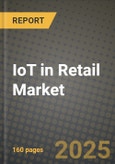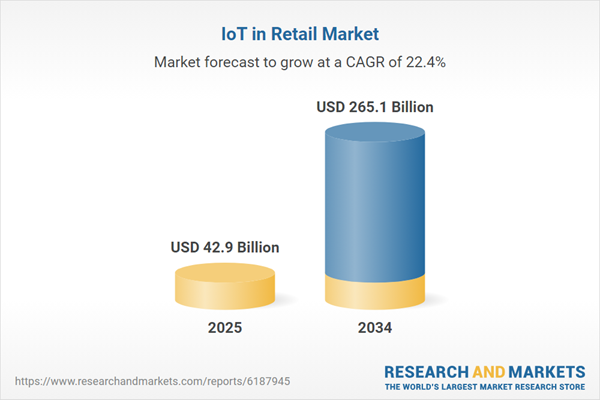The IoT in Retail Market enables retailers to transform physical stores, warehouses, and supply chains through connected devices, real-time analytics, and automated systems. From smart shelves and inventory sensors to connected checkout systems and customer-tracking technologies, IoT offers end-to-end visibility and control over retail operations. Retailers use IoT to enhance the shopper experience, optimize stock levels, streamline logistics, reduce shrinkage, and create personalized engagement through data. In both brick-and-mortar and omnichannel environments, IoT allows for adaptive merchandising, dynamic pricing, and demand forecasting. As competition intensifies and consumers expect seamless, tech-enhanced retail experiences, IoT is rapidly becoming a differentiator in the pursuit of efficiency, personalization, and profitability.
The retail sector accelerated IoT adoption across use cases from inventory automation to interactive customer service. Major retailers like Walmart, Amazon Fresh, and Carrefour implemented smart shelves that monitor product availability and automatically reorder stock. IoT-enabled cameras and RFID tags tracked in-store traffic patterns, allowing real-time optimization of product placement and layout. Checkout experiences were revolutionized by touchless payment kiosks, mobile self-scan solutions, and AI-based queue management. Cold chain monitoring for groceries and pharmaceuticals became critical, with temperature and humidity sensors ensuring freshness and compliance. Cloud-based retail platforms integrated with IoT dashboards gave store managers visibility into asset health, energy consumption, and customer behavior analytics - all updated in real time.
The IoT in retail will shift toward predictive, autonomous, and hyper-personalized environments. Retailers will deploy edge AI to deliver personalized promotions based on real-time customer movement and historical data. Robotic assistants and drones will automate in-store restocking and inventory audits. Digital twin models of retail environments will simulate foot traffic, optimize planograms, and test promotional strategies virtually. Blockchain and IoT will converge for transparent supply chain tracking, enhancing trust in food, apparel, and luxury goods. Energy-efficient IoT systems will help retailers meet sustainability goals by reducing lighting and refrigeration costs. Ultimately, IoT will empower retailers to offer smarter, safer, and more immersive shopping experiences that bridge digital and physical commerce.
Key Insights: IoT In Retail Market
- The analyst highlights the rise of smart shelves and RFID-enabled inventory systems that automatically track product movement, reduce stockouts, and send alerts for restocking in real time.
- Touchless checkout and mobile point-of-sale technologies are trending, enabling frictionless payment experiences and reducing queuing times in physical stores through IoT-enabled self-service platforms.
- According to the analyst, in-store analytics using smart cameras and foot traffic sensors are helping retailers optimize product placement and improve store layout to increase conversions and dwell time.
- IoT-based cold chain monitoring is growing in importance for grocers and pharmacies, ensuring compliance with safety regulations and reducing waste by tracking temperature and humidity in real time.
- Personalization engines powered by IoT and AI are emerging, where in-store digital displays and promotions dynamically change based on customer profiles, movement, and engagement history.
- The analyst identifies the push for real-time visibility into inventory and customer behavior as a major driver for IoT adoption across both large-format retail and boutique environments.
- Changing consumer expectations for convenience, personalization, and seamless omnichannel experiences are prompting retailers to integrate IoT into store operations and loyalty programs, says the analyst.
- The analyst notes that labor shortages and rising operational costs are accelerating automation in retail, from smart restocking systems to robotic floor cleaning and digital shelf labeling.
- The need for better supply chain traceability and quality assurance - especially in food and pharmaceutical segments - is driving adoption of IoT tracking and environment-monitoring solutions.
- The analyst highlights the challenge of retrofitting IoT infrastructure into legacy retail environments, which often lack the connectivity or power infrastructure to support modern IoT sensors and gateways.
- According to the analyst, data security and consumer privacy concerns - especially in facial recognition and behavior tracking - require careful policy development and compliance with evolving global regulations.
IoT In Retail Market Segmentation
By Offering
- Solution
- Service
By Type
- Beacons
- RFID Tags
- Sensors
- Wearables
- Other Types
By Technology
- Bluetooth low energy
- Near field communication
- ZigBee
- Other Technologies
By Deployment Mode
- On-premise
- Cloud
By Application
- Supply Chain Operations Management
- Customer Management
- Sales and Customer Management
- Asset Management
- Other Applications
Key Companies Analysed
- ARM Limited
- Cisco Systems Inc.
- Alphabet Inc.
- IBM Corporation
- Impinj Corporation
- Intel Corporation
- Microsoft Corporation
- PTC Inc.
- RetailNext Inc.
- SAP SE
- Softweb Solutions Inc.
- Zebra Technologies Corporation
- Huawei Technologies Company Limited
- Amazon Web Services Inc.
- Software AG
- Bosch Software Innovations GmbH
- NEC Corporation
- Oracle Corporation
- Vodafone Group Plc.
- Allergen Technologies Private Limited
- Sierra Wireless Inc.
- Happiest Minds Technologies Limited
- Losant IoT Inc.
- NXP Semiconductors N.V.
- Verizon Communications Inc.
- Freescale Semiconductor Inc.
- Xively Inc.
- Microchip Technology Incorporated
- Bsquare Corporation
- Fujitsu Limited
- Hewlett Packard Enterprise Development LP.
IoT In Retail Market Analytics
The report employs rigorous tools, including Porter’s Five Forces, value chain mapping, and scenario-based modeling, to assess supply-demand dynamics. Cross-sector influences from parent, derived, and substitute markets are evaluated to identify risks and opportunities. Trade and pricing analytics provide an up-to-date view of international flows, including leading exporters, importers, and regional price trends.Macroeconomic indicators, policy frameworks such as carbon pricing and energy security strategies, and evolving consumer behavior are considered in forecasting scenarios. Recent deal flows, partnerships, and technology innovations are incorporated to assess their impact on future market performance.
IoT In Retail Market Competitive Intelligence
The competitive landscape is mapped through proprietary frameworks, profiling leading companies with details on business models, product portfolios, financial performance, and strategic initiatives. Key developments such as mergers & acquisitions, technology collaborations, investment inflows, and regional expansions are analyzed for their competitive impact. The report also identifies emerging players and innovative startups contributing to market disruption.Regional insights highlight the most promising investment destinations, regulatory landscapes, and evolving partnerships across energy and industrial corridors.
Countries Covered
- North America - IoT In Retail market data and outlook to 2034
- United States
- Canada
- Mexico
- Europe - IoT In Retail market data and outlook to 2034
- Germany
- United Kingdom
- France
- Italy
- Spain
- BeNeLux
- Russia
- Sweden
- Asia-Pacific - IoT In Retail market data and outlook to 2034
- China
- Japan
- India
- South Korea
- Australia
- Indonesia
- Malaysia
- Vietnam
- Middle East and Africa - IoT In Retail market data and outlook to 2034
- Saudi Arabia
- South Africa
- Iran
- UAE
- Egypt
- South and Central America - IoT In Retail market data and outlook to 2034
- Brazil
- Argentina
- Chile
- Peru
Research Methodology
This study combines primary inputs from industry experts across the IoT In Retail value chain with secondary data from associations, government publications, trade databases, and company disclosures. Proprietary modeling techniques, including data triangulation, statistical correlation, and scenario planning, are applied to deliver reliable market sizing and forecasting.Key Questions Addressed
- What is the current and forecast market size of the IoT In Retail industry at global, regional, and country levels?
- Which types, applications, and technologies present the highest growth potential?
- How are supply chains adapting to geopolitical and economic shocks?
- What role do policy frameworks, trade flows, and sustainability targets play in shaping demand?
- Who are the leading players, and how are their strategies evolving in the face of global uncertainty?
- Which regional “hotspots” and customer segments will outpace the market, and what go-to-market and partnership models best support entry and expansion?
- Where are the most investable opportunities - across technology roadmaps, sustainability-linked innovation, and M&A - and what is the best segment to invest over the next 3-5 years?
Your Key Takeaways from the IoT In Retail Market Report
- Global IoT In Retail market size and growth projections (CAGR), 2024-2034
- Impact of Russia-Ukraine, Israel-Palestine, and Hamas conflicts on IoT In Retail trade, costs, and supply chains
- IoT In Retail market size, share, and outlook across 5 regions and 27 countries, 2023-2034
- IoT In Retail market size, CAGR, and market share of key products, applications, and end-user verticals, 2023-2034
- Short- and long-term IoT In Retail market trends, drivers, restraints, and opportunities
- Porter’s Five Forces analysis, technological developments, and IoT In Retail supply chain analysis
- IoT In Retail trade analysis, IoT In Retail market price analysis, and IoT In Retail supply/demand dynamics
- Profiles of 5 leading companies - overview, key strategies, financials, and products
- Latest IoT In Retail market news and developments
Additional Support
With the purchase of this report, you will receive:- An updated PDF report and an MS Excel data workbook containing all market tables and figures for easy analysis.
- 7-day post-sale analyst support for clarifications and in-scope supplementary data, ensuring the deliverable aligns precisely with your requirements.
- Complimentary report update to incorporate the latest available data and the impact of recent market developments.
This product will be delivered within 1-3 business days.
Table of Contents
Companies Mentioned
- ARM Limited
- Cisco Systems Inc.
- Alphabet Inc.
- IBM Corporation
- Impinj Corporation
- Intel Corporation
- Microsoft Corporation
- PTC Inc.
- RetailNext Inc.
- SAP SE
- Softweb Solutions Inc.
- Zebra Technologies Corporation
- Huawei Technologies Company Limited
- Amazon Web Services Inc.
- Software AG
- Bosch Software Innovations GmbH
- NEC Corporation
- Oracle Corporation
- Vodafone Group PLC
- Allergen Technologies Private Limited
- Sierra Wireless Inc.
- Happiest Minds Technologies Limited
- Losant IoT Inc.
- NXP Semiconductors N.V.
- Verizon Communications Inc.
- Freescale Semiconductor Inc.
- Xively Inc.
- Microchip Technology Incorporated
- Bsquare Corporation
- Fujitsu Limited
- Hewlett Packard Enterprise Development LP .
Table Information
| Report Attribute | Details |
|---|---|
| No. of Pages | 160 |
| Published | October 2025 |
| Forecast Period | 2025 - 2034 |
| Estimated Market Value ( USD | $ 42.9 Billion |
| Forecasted Market Value ( USD | $ 265.1 Billion |
| Compound Annual Growth Rate | 22.4% |
| Regions Covered | Global |
| No. of Companies Mentioned | 31 |









